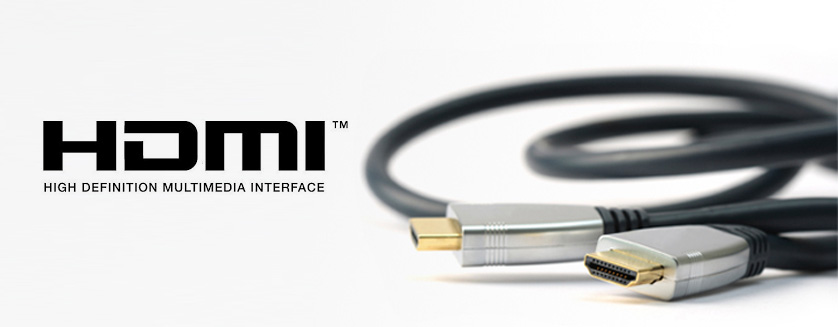HDMI (High-Definition Multimedia Interface) is a proprietary audio/video interface used in almost all of today's modern TV's, projectors, monitors, and other A/V devices such as Blu-Ray players, game consoles and receivers.
History
Development of HDMI started in 2002 with the goal of simplifying all the different A/V cables into one cable with small connectors to save space on devices. Previously audio and video were routed between home theatre components through seperate cables; HDMI combines both into one cable with a connector smaller than the more popular digital video connector at the time - DVI. By 2007 HDMI had become the de facto standard for HDTV's with over 90% of the market supporting the interface.
Features
Besides simplifying cabling and shrinking the connector HDMI adds the following features:
- E-DDC (Enhanced Display Data Channel) - Not only does this let your A/V components know each other's capabilities (for example your TV's resolution) but is also used by HDCP (High Bandwidth Digital Content Protection) to prevent piracy.
- CEC (Consumer Electronics Control) - This communications channel allows HDMI connected devices to control each other, such as slipping in a BD or DVD disc will automatically switch your TV to the BD/DVD player or switching your receiver off causes everything else to go to stand-by. Theoretically CEC also enables one device's remote to control all your home theater components but, your milage may vary as different manufacturers implementation may be incompatible with others.
- ARC (Audio Return Channel) - This feature allows a smart TV to send audio back to the receiver without the need of an extra audio cable (for example if were watching Netflix via an app on your TV but want your sound to come from your main speakers). Usually only one port is ARC enabled so make sure to reserve that one for your receiver. Also please note some TV's only support stereo via ARC, please see your TV's user manual if 5.1 surround sound is suppported via ARC.
- MHL (Mobile High-Definition Link) - This feature allows you to connect a smart phone or tablet to a HDTV and use the TV remote to control the smartphone/tablet. The MHL enabled port also provides power so your device doesn't run out of battery while connected or need a separate charging cord. Usually one port on a TV is MHL enabled so please keep that port available for your mobile devices.
The above is not an exhaustive feature list of HDMI but some of the more customer noticeable ones. For a full list please visit the interface's homepage at www.hdmi.org.
Connectors
Most HDMI enabled devices use the standard Type A connector. The Type C and Type D connectors are mainly used by mobile devices to save space. All the connectors are keyed to only fit one way. If you are having trouble please try flipping the cable around.
What's new for HDMI 2
The current version of HDMI found on most of today's graphics cards will not support 4K monitors at the usual 60Hz nor will it support some of the ultra-wide 21:9 aspect ratio monitors just recently coming onto the market. This is because the current HDMI specifications do not have enough bandwidth to support those resolutions and has nothing to do with the graphics processor as many of these cards also come with Display Port which will support those resolutions. HDMI 2 will fix both these issues and add additional features. The good news is you shouldn't have to buy new cables, any recently bought HDMI cable will work with the new version just fine.
Conclusion
With HDMI dominating the home theater market it was only natural for the interface to infiltrate the computer market, as many users connect PC's to such systems for presentation purposes. Now HDMI is a must have on laptops and have even made their way onto desktop computer monitors and video cards, making it the dominant display interface in the world.



